Standards Worldwide
Standards Worldwide
Phone +49 30 58885700-07

Standard [CURRENT]
ASTM F 2148:2018
Standard Practice for Evaluation of Delayed Contact Hypersensitivity Using the Murine Local Lymph Node Assay (LLNA)
- Publication date
- 2018
- Original language
- English
- Pages
- 5
- Publication date
- 2018
- Original language
- English
- Pages
- 5
Product information on this site:
Quick delivery via download or delivery service
Buy securely with a credit card or pay upon receipt of invoice
All transactions are encrypted
Short description
1.1 This practice provides a methodology to use a combination of in vivio and in situ procedures for the evaluation of delayed contact hypersensitivity reactions. 1.2 This practice is intended to provide an alternative to the use of guinea pigs for evaluation of the ability of a device material to stimulate delayed contact hypersensitivity reactions. This alternative is particularly applicable for materials used in devices that contact only intact skin. However, the guinea pig maximization test is still the recommended method when assessing the delayed hypersensitivity response to metals or when testing substances that do not penetrate the skin but are used in devices that contact deep tissues or breached surfaces. This practice may be used for testing metals, with the exception of nickel-containing metals, unless the unique physicochemical properties of the materials may interfere with the ability of LLNA to detect sensitizing substances. 1.3 This practice consists of a protocol for assessing an increase in lymphocyte proliferation in the lymph nodes draining the site of test article administration on the ears of mice. 1.4 The LLNA has been validated only for low-molecular-weight chemicals that can penetrate the skin. The absorbed chemical or metabolite must bind to macromolecules, such as proteins, to form immunogenic conjugates. 1.5 This practice is one of several developed for the assessment of the biocompatibility of materials. Practice F748 may provide guidance for the selection of appropriate methods for testing materials for a specific application. 1.6 Identification of a supplier of materials or reagents is for the convenience of the user and does not imply a single source. Appropriate materials and reagents may be obtained from many commercial supply houses. 1.7 The values stated in SI units are to be regarded as standard. No other units of measurement are included in this standard. 1.8 This standard does not purport to address all of the safety concerns, if any, associated with its use. It is the responsibility of the user of this standard to establish appropriate safety, health, and environmental practices and determine the applicability of regulatory limitations prior to use. 1.9 This international standard was developed in accordance with internationally recognized principles on standardization established in the Decision on Principles for the Development of International Standards, Guides and Recommendations issued by the World Trade Organization Technical Barriers to Trade (TBT) Committee.
Loading recommended items...
Loading recommended items...
Loading recommended items...
Loading recommended items...
